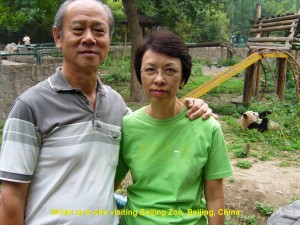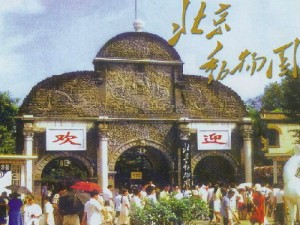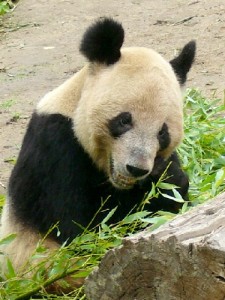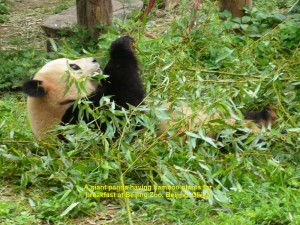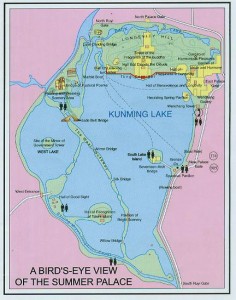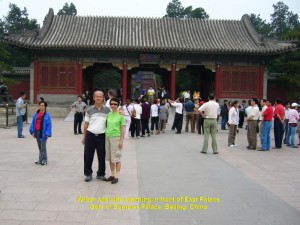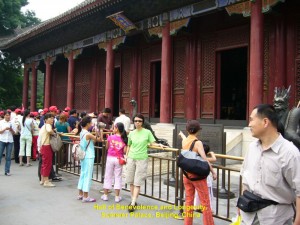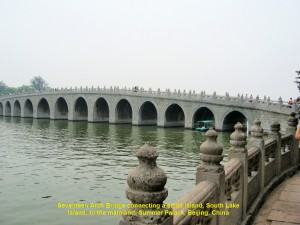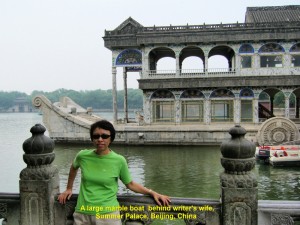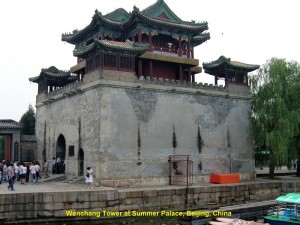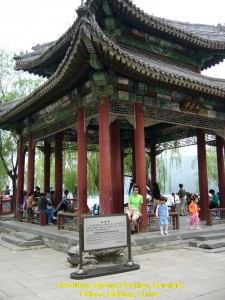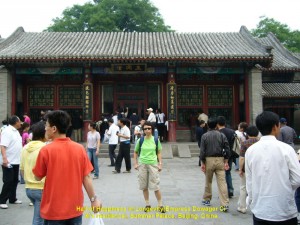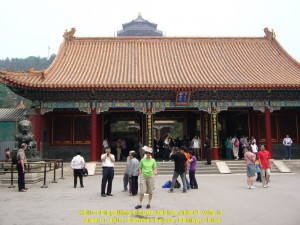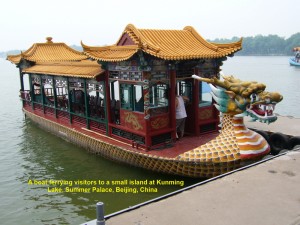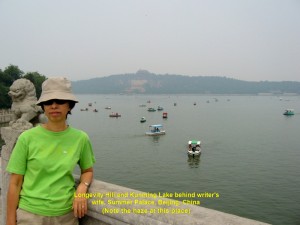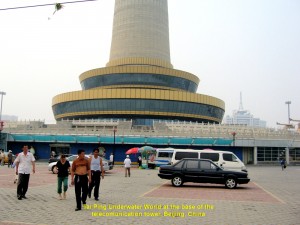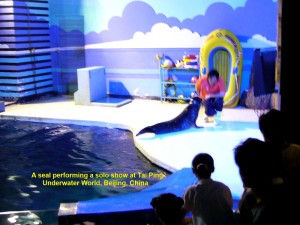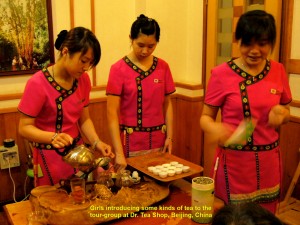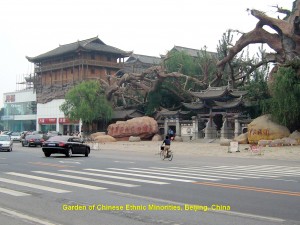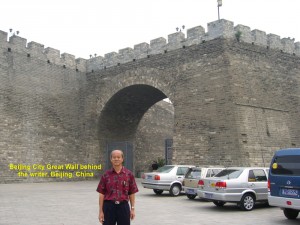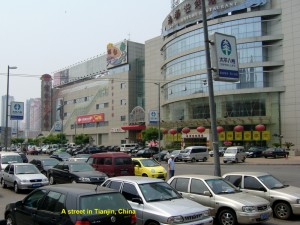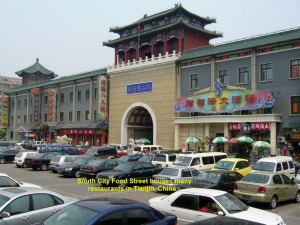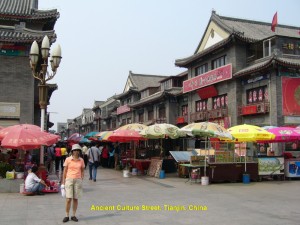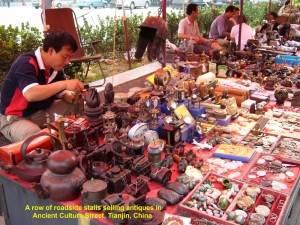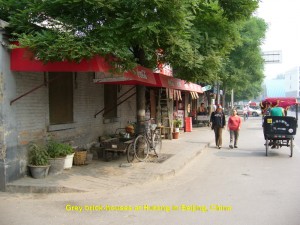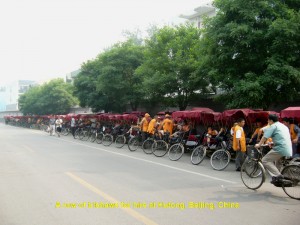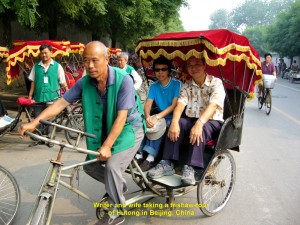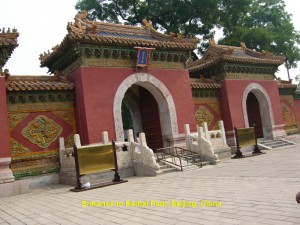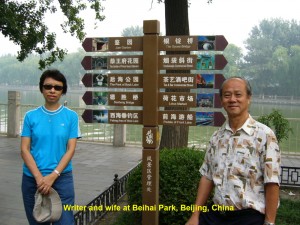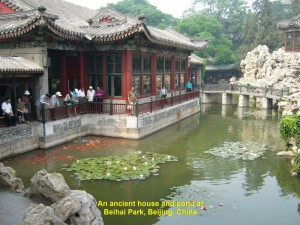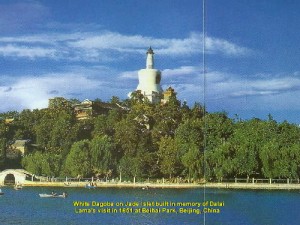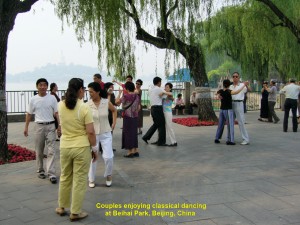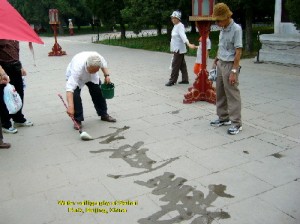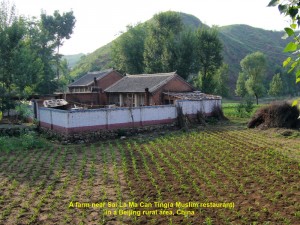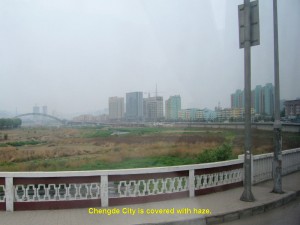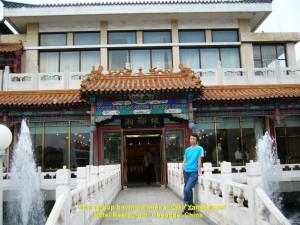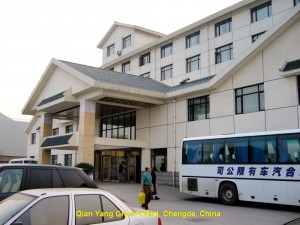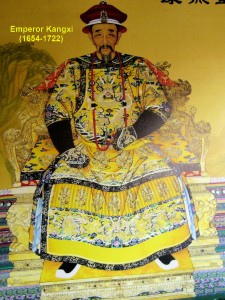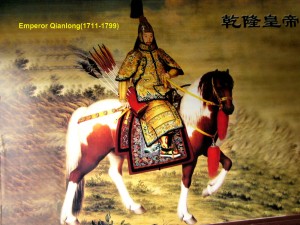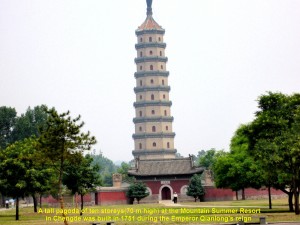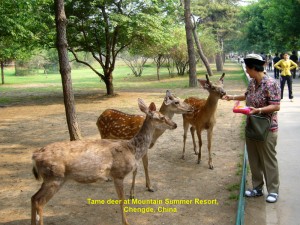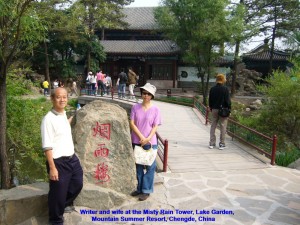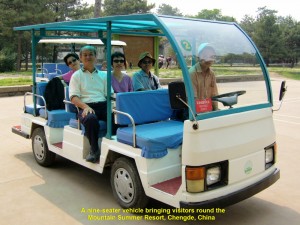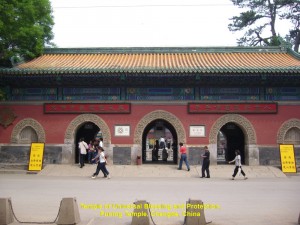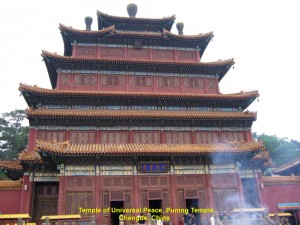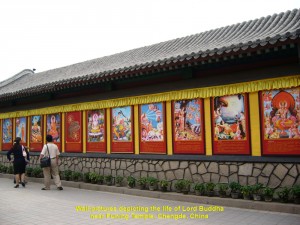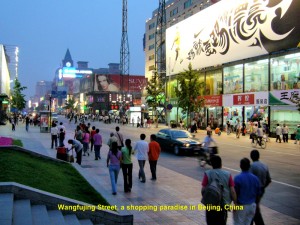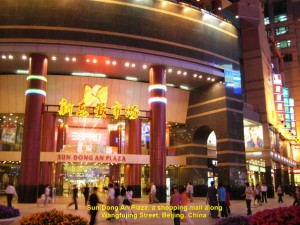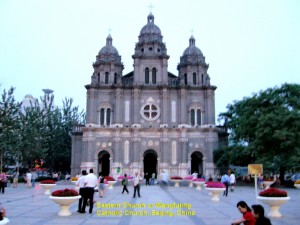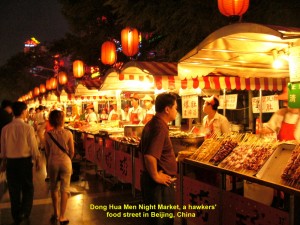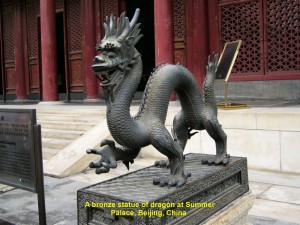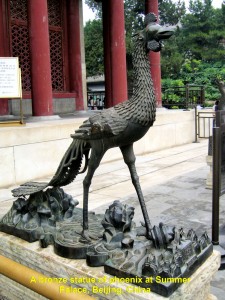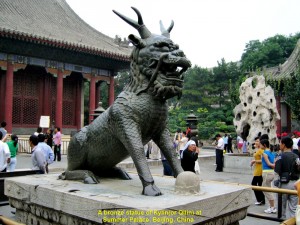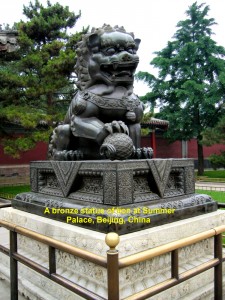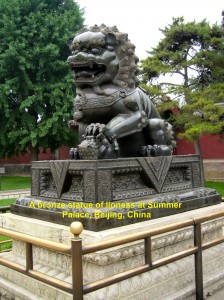Beijing, Tianjin, Chengde Travel (Part II)
Filed under: Chengde Travel II
{(continued from Beijing, Tianjin, Chengde Travel (Part I)}
Beijing, Tianjin, Chengde Travel Part II
Day 4: Saturday, 3 June 2006 Beijing Zoo
On the morning of 3 June 2006, we went to Beijing Zoo. It covers a large area of 86 hectares and claims to have over 7,000 animals from 600 different species, ranging from fish to mammals. The zoo is about 100 years old. Animals from many parts of the world live here, including tigers, polar bears, monkeys, giraffes, rhinos, penguins, kangaroos, elephants, zebras and lions.
On arrival at the zoo in the morning, we went straight to a building to see giant pandas. When we were inside, we felt elated to see three large, dirty giant pandas sitting on the ground in their own enclosures busy eating bamboo plants for their breakfast.
Giant Pandas
Giant pandas are now endangered animals. There are about 1,000 left in the world and half of them are in captivity. Zoo scientists are worried as the population of these animals is decreasing. They are now trying frantically to breed them in the wild and captivity. They have done it with little success as male and female giant pandas are not very cooperative.
After a few minutes of excitement of watching the animals, we left the zoo for a well-known tourist spot in Beijing, Summer Palace.
Summer Palace
Located 15 km north-west of the centre of Beijing, it covers an area of 291 hectares and three quarters of it is lake. It is one of the most charming, splendid and classical gardens in the world.
In the olden days, pleasure-seeking feudal rulers spent their leisure time at the beautiful garden. Later it became an imperial garden during the Ming and Qing Dynasties.
In 1888 Empress Dowager Ci Xi spent a large amount of money which was meant for building a Chinese navy to rebuild the garden. She named it “Park of Nurtured Harmony” but now it is commonly known as “Summer Palace”.
Interesting Attractions
There are many interesting attractions at Summer Palace including the following:
1. Tower of the Fragrance of Buddha sitting on the Hill of Longevity (a three-storeyed octagonal building with a height of 41 metres)
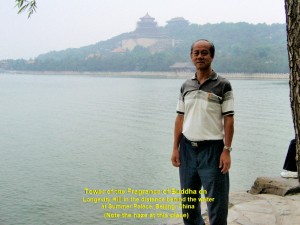
Tower of the Fragrance of Buddha on Longevity Hill in the distance behind the writer, Summer Palace, Beijing, China
2. Hall of Benevolence and Longevity (where Empress Dowager Ci Xi and Emperor Guangxu held court and administered state affairs)
3. The Long Corridor (which is 728 metres long and has 14,000 pictures painted on its ceiling)
4. Seventeen-Arch Bridge (connecting a small island, South Lake Island, in Kunming Lake to the land, 150 metres long and having 544 different small stone lions on its balustrades)
5. Marble Boat (which is 36 metres long and has a hull and upper deck)
6. Wenchang Tower(a two-storeyed building housing the bronze statue of the God of Literary Prosperity)
7. Heralding Spring Pavilion (an ideal place to appreciate the scenic landscape of Kunming Lake and the Longevity Hill)
8. Hall of Happiness in Longevity (Empress Dowager Ci Xi’s residential quarters)
9. Glowing Clouds and Holyland Archway (standing by the Kunming Lake to dispel clouds)
10. Hall of Dispelling Clouds
An Emperors’ Retreat
Summer Palace which has many beautiful buildings, tree-covered hills and a splendid lake (Kunming Lake) was obviously a retreat for the emperors of China who wanted to escape from the scorching summer heat of Beijing.
Now Summer Palace is a popular place for local people who go there for their recreational activities such as folk and modern dancing, singing, playing Chinese ancient musical instruments, using water and big brushes to write Chinese characters on cemented ground, performing tai-chi and qi gong and playing Chinese chess and cards. Others like to spend their time mingling with the tourists.
In 1998, UNESCO designated Summer Palace as a World Cultural Heritage.
A Tour
At Summer Palace, we spent a few hours strolling and enjoying the scenic views of the Kunming Lake, hills, temples and quaint buildings. We took a ride in a colourful boat at Kunming Lake from a jetty near Gate That Dispels The Clouds to a small island known as South Lake Island and then walked across Seventeen Arch Bridge to Heralding Spring Pavilion . At the pavilion, we were entertained by a group of Chinese musicians and singers.
After touring the large, pristine Summer Palace, we left for a pearl-jewellery shop known as Jubao Tang Jewellery Centre in Beijing.
Jubao Tang Jewellery Centre, Beijing
When we arrived at a pearl factory, Jubao Tang Jewellery Centre in Beijing, we were ushered into a room. Then we were shown a tray of live freshwater oysters. As a worker was prising an oyster, she asked us to guess the number of pearls it had produced. We were
astonished when she opened it and counted 28 little pearls in it. None of us got the answer right. Then she told us that pearls can be produced in many colours by giving oysters different kinds of food. After that interesting oyster lesson we moved on to a larger room where all kinds of pearl-jewellery were displayed in showcases. We were persuaded by salesgirls and salesmen to buy them. Some of us bought the inexpensive ones.
Tai Ping Underwater World
The next place we went to was a small aquarium in Hai Dian District known as Tai Ping Underwater World. Arriving at the aquarium, we noticed that it is under a tall telecommunication tower. We went inside to see the fish but were disappointed as there were not many exotic fish there. But we were pleasantly surprised to see a little, pretty lady in red mermaid costume swimming slowly in a large aquarium.
Later, we went into a small crowded room to watch a seal performing an entertaining solo show which lasted for about 10 minutes.
Dr. Tea
After the seal show we left for a tea shop known as Dr. Tea. It is located at No. 1, Min Zu Yuan Road, Chaoyang District, Beijing. In the shop we were introduced to many kinds of tea, such as jasmine tea, ‘The King of Oolong Tea’, wild ‘puer’ tea, ‘tian qi’ flower and black tea. We tasted some of them and were told that each kind of tea could cure a specific ailment.
Garden of Chinese Ethnic Minorities
Near the tea-shop is a large area where 16 Chinese ethnic minorities’ architectural buildings are built in the same scale as the normal ones. This area is known as the Garden of Chinese Ethnic Minorities. It is a showcase of 16 Chinese ethnic minorities’ traditions, customs and cultures. Ethnic festival activities, dancing and singing performances, handicraft-making, cuisine-tasting and many more are held here. Owing to time constraint, we missed that place.
Day 5: Sunday, 4 June 2006 Min City Site Park
On the morning of 4 June 2006, we visited Min City Site Park in the Beijing suburb. At this park, there is a 1.5 km long Beijing City Great Wall. It is the remainder of the 40 km city great wall which was built during the Ming Dynasty to protect the city. This short great wall is 8.2 metres high and has a large tower known as Corner Tower. In this tower, there are four flours. The first and fourth flours house modern paintings and sculptures by outstanding young Chinese artists and sculptors whereas the third floor shows the history, politics, economy and cultures of the Chongmen District since Qin and Han Dynasties.
In 1916, an arch which is 7.4 metres high and 9.5 metres wide was built in the great wall near the tower at the park. It was built for the round-the-capital railway. Now the line is not there anymore.
After visiting the park, we moved on to Tianjin which is 137 km south-east of Beijing.
Tianjin
Tianjin known as “The Diamond of the Bohai Gulf” is the 3rd. largest city in China. It is one of the biggest industrial and port cities in China and the closest seaport to Beijing. It has a population of about 10 million.
The coach journey from Beijing to Tianjin took about two hours as the traffic on the road was heavy. Our purpose of going to Tianjin was to taste the famous Tianjin’s steamed dumplings known as “Gou Bu Li” dumplings and visit Ancient Food Street and Culture Street.
“Gou Bu Li” Dumplings
On arrival at Tianjin, we went straight to a restaurant to taste the famous “Gou Bu Li” dumplings (‘Gou Bu Li’ literally means ‘Dogs Ignore’). They are small white dumplings stuffed with little meat and green leafy vegetables. We ate a few different types but found that there was nothing special about them.
Why are Tianjin’s steamed dumplings called “Gou Bu Li”? We were told that about 120 years ago there was a man selling steamed dumplings. His customers liked to call him “Gou Bu Li”, his childhood’s name. Soon his dumplings were also known as “Gou Bu Li” dumplings. That is how the famous Tianjin’s dumplings get the name.
Ancient Food Street
After a meal of dumplings, we went to Ancient Food Street where there is a large building with its front built in ancient Chinese architectural style and a pair of guardian lions at its entrance. It houses many stalls which sell a variety of snacks, cooked meats, preserved fruits, nuts, souvenirs, arts, handicrafts, etc. on the ground floor and Chinese restaurants on the first flour.
Ancient Culture Street
Later we went to a well-known place in Tianjin called Ancient Culture Street which is located in the north-eastern part of the old city of Tianjin. Two and three storey buildings built in ancient Chinese architectural style line the street. They sell a wide variety of Chinese arts and handicrafts, antiques, souvenirs, Chinese brushes of all sizes, etc.
Tianhou Palace
Situated near Ancient Culture Street is the oldest building in Tianjin known as Tianhou Palace (built in 1326). Local people prayed to the Goddess of the Sea to bless the seafarers of Tianjin at that place. Later, in 1984, it became a museum. Since then it showcases the history, customs and traditions of Tianjin
In the late afternoon, we returned to Beijing.
Day 6: Monday 5 June 2006 Beijing Hutong
On the morning of 5 June 2006, we visited the Hutong in the centre of Beijing City. Literally, “hutong” in Chinese means small lanes or alleys. But the Hutong is actually an old residential place where houses are built around courtyards and has a maze of small lanes. Many hutongs in Beijing have been demolished and replaced by modern high-rise buildings and apartments.
A Hutong Visit
The Hutong we went to is sandwiched between a lake (Hihai, Houhai and Qianhai) in the north and another lake, Beihai, in the south. When we arrived there, we were astonished to see a long row of trishaws parked on one side of a busy road waiting for tourists. My wife and I sat on one them. When all the members of my tour group were seated in their trishaws, the trishawmen started to tour the Hutong. As the Hutong lanes are narrow, trishaws have to move in a single file.
A Bumpy Ride
It was a bumpy ride at the Hutong as the road surface was uneven. Sometimes we were thrown to one side when our trishawman avoided an oncoming trishaw or negotiating a sharp corner. I would say that the ride was very uncomfortable.
Passing through the place, we managed to get quick glimpses at the Hutong where the old, small grey brick-houses were built close to each other. There are a few more interesting attractions in this area, such as the Bell and Drum Tower, Prince Gong’s Residence and Mei Lanfang Memorial Hall.
The trishawmen finally brought us all back to the place where we had started. Then we walked across a busy road, Di’anmen Xi Dajie, to a beautiful garden known as Beihai Park.
Beihai Park
Located in the heart of Beijing, Beihai Park is well-known for its Jade Islet, Beihai Lake and White Dagoba.
White Dagoba
White Dagoba is 35.9 metres high and built on Jade Islet as a memorial to the Dalai Lama’s visit in 1651. Adjacent to White Dagoba is Circular City. It is a ‘small city’ in the city proper of Beijing. Hall of Receiving Light is in the Circular City centre where an 800-year-old pine tree is growing.
Nine Dragon Screen
Beihai Park which is a classical garden with pavilions, halls, temples and covered corridors was an imperial garden. It has a beautiful wall known as Nine Dragon Screen. Both sides of the wall are artistically decorated with 9 large flying dragons chasing fiery large pearls on each side. Besides, the wall has 635 small dragons. It is 5.96 m high, 1.6 m thick and 25.52 m long and was constructed in 1756. It required 4,247 coloured-glazed tiles to make this masterpiece. It is the only kind which has both sides of the wall decorated in China.
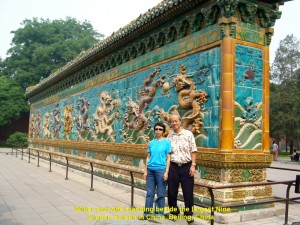
The largest nine-dragon screen or wall behind writer and wife in China is at Beihai Park, Beijing, China
A Recreational Park
Beihai Park is a popular recreational place for local people. They spend their leisure time doing relaxing recreational activities, like folk and modern dances, water-calligraphy on cemented pathway, tai-chi, Chinese chess game, singing and sword practice.
Muslim Food
After strolling at the beautiful pristine Beihai Park, we left for Chengde. On the way, we stopped for lunch at a small Muslim restaurant known as Sai La Ma Can Ting along Ju Xiang Qiao Road. Entering the restaurant, we were surprised to see 28 tourists from our own country, Malaysia, having lunch. “It’s a small world,” we said to each other. After exchanging greetings, we settled down to have our own meals.
Journey to Chengde
Then we continued our journey to Chengde which is 230 km north-east of Beijing . In the middle of the journey, we saw ruined Great Wall of China on the hills in the distance. After travelling for 4 hours on the busy highway, we finally reached the city in the evening. It was covered with haze. We had dinner at a restaurant at Qian Yang Grand Hotel, 18, Pule Road, Chengde. After dinner. we checked in at the three-star hotel, Qian Yang Grand Hotel and looked forward to a tour in Chengde on the following day.
Day 7 : Tuesday 6 June 2006 Chengde
Chengde with a population of 3.4 million is known as “The Pearl Outside the Great Wall”. A wide river, Pule River, flows through the city from north to south. When we were there, we saw little water flowing in the river due to a long period of drought.
Mountain Summer Resort of Chengde
On the morning of 6 June 2006, we had breakfast at the Qiang Yang Great Hotel restaurant. I could not eat much as the dishes given to us were cold.
After breakfast, we went to a famous imperial resort in Chengde known as Mountain Summer Resort. When we arrived there, our local tour-guide, Miss Chang, brought us round to see the important spots of the resort.
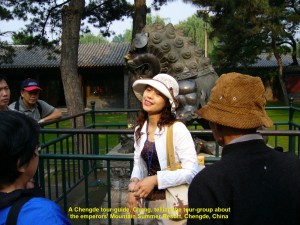
Chengde tour-guide, Chang, talking about the Mountain Summer Palace to the tour-group, Chengde, China
The Largest Imperial Garden
Located in the northern part of Chengde City, Mountain Summer Resort is the largest imperial garden in China. It has 10 km wall round it and covers a large area of 5.64 sq. km. which is twice as big as Summer Palace in Beijing. The Qing emperors, Kangxi and Qianlong, took 89 years (1703-1792) to build the resort.
Grand palaces, temples, pagodas and pavilions were built all over the resort. The resort has a dense forest where lots of animals once roamed in the north and a large grassland where many reindeer once grazed in the north-east. Nowadays, a few tame reindeer can be seen roaming freely in the resort. In the olden days, the forest and the grassland were the emperors’ favourite hunting grounds.
In this resort, a large wooden building known as Hall of Frugality and Simplicity (Dan Bo Jing Cheng) which was built in 1711 was an important place where the emperors handled state affairs and held grand ceremonies during their vacation there. This building is now closed but tourists can peep inside through glass-covered doors and windows. Surprisingly, some Chinese money notes can be seen stuck in the gaps of doors and windows. Some tourists must have done hoping to be blessed by the spirits of the dead emperors.
Treaty of Beijing in 1860
Another large quaint wooden building, Hall of Refreshing Mists and Waves (Yan Bo Zhi Shuang), which was also built in 1711, was the emperors’ residence. It was in that building where Emperor Xianfeng signed the Treaty of Beijing in 1860 which forced China to give up South Kowloon to Britain and a large territory north of Heilongjiang River and east of Wusulijiang River to Russia.
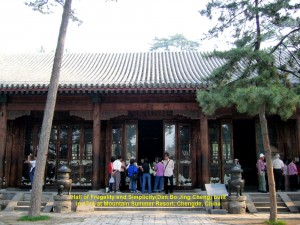
Hall of Frugality and Simplicity where Treaty of Beijing was signed in 1860, Mountain Summer Resort, Chengde, China
The most beautiful and romantic spot in the resort is the scenic lake garden in the south-east. A stroll in the garden where there are buildings and pavilions in splendid ancient Chinese architectural style, stone bridges built across the lake, lotus flowers growing in the lake and coloured fish swimming in the water will definitely
make a tourist feel relaxed and refreshed. No wonder, Emperor Qianlong and Emperor Kangxi liked to stay at the resort during summer for about half a year annually.
To go round the large resort, we took a nine-seater electric-powered vehicle ride. It brought us to a few popular spots in the resort.
After touring the picturesque, pristine resort, we went to another place near Mountain Summer Resort where there is a well-known
temple in Chengde City, Temple of General Peace or commonly known as Puning Temple.
Puning Temple
Puning Temple was built in 1755 by Emperor Qianlong during the Qing Dynasty. It was built in the same architectural style as that of the Tibetan Sanmoye Temple. There are many other buildings in this area of 33,000 sq. metres, such as Bell and Drum Towers, Pavilions, Hall of the Heavenly Kings, Temple of Universal Blessing and Protection and Temple of Universal Peace.
Temple of Universal Peace
Among the buildings, Temple of Universal Peace is the largest. It houses the world’s largest wood-carved Buddha statue. It has a height of 22.3 metres and width 15 metres. Unlike other statues of Buddha, this large one has a thousand hands and a thousand eyes. Ironically, the people of Chengde call the figure “The Goddess of Mercy (Guanyin) with a Thousand hands and Thousand eyes”. We saw many worshippers praying to the deities and Buddha and some lamas playing ancient musical instruments in front of that large temple.
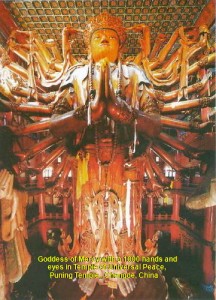
Goddess of Mercy with 1000 hands and eyes in Temple of Universal Peace, Puning Temple, Chengde, China
Hall of the Heavenly Kings houses four large statues of warriors, namely East Chiguo, South Zengshang, West Guangmu and North Duowen.
A tour at this sacred place, Puning Temple, teaches us a significant part of the local tradition and culture.
Life of Lord Buddha
Adjacent to the temple is a wall with colourful pictures depicting the life of Lord Buddha. After this wall is an entrance to a mini cultural village which has a lane with single-storey shops on both sides. The shops built in the Qing architectural style sell all kinds of souvenirs, Chinese paintings, crystal and jade products, post-cards, etc.
Later we left that sacred place and returned to Beijing.
Ya Show Clothing Market
On arrival at Beijing we went straight to a large departmental store known as Ya Show Clothing Market in Gong Ti Bei Street. It is a place where one can buy anything one wants : goods ranging from belts, shoes, clothes and handbags to watches, digital cameras, MP4, thumb-drives and picture-cards of 2 gigabytes.
Most of the vendors here will set their goods at prices that are astronomically high. It is advisible for a buyer to reduce their prices to between one third and one quarter before purchasing them. Buyers are forewarned that most of the goods here are not genuine ones.
After buying some goods at bargain prices, we left for a restaurant where we had Siamese food for dinner. While having dinner, we were entertained by young singers who performed a Siamese and then a native dance on a small stage.
Wangfujing Street (Wangfujing Da Jie)
After dinner we went to a popular tourists’ street known as Wangfujing Da Jie in Beijing City. It is about 1 km long. Along this busy street are several large shopping complexes which (our tour guide claimed) sell genuine branded goods. Among them are Sung Dong An Plaza, Beijing Departmental Store, Beijing Arts and Crafts Shop and Shidu Emporium. The former is the largest shopping mall in Beijing.
Eastern Church or Wang Fujing Catholic Church
While walking down the street to Sung Dong An Plaza, we saw a catholic church known as Eastern Church or Wang Fujing Catholic Church. We were surprised to see it as it was the first church we saw in Beijing after so many days of stay in the city.
Dong Hua Men Night Market Street
Then we walked to another street nearby, Donganmen Da Jie, and were attracted by a row of about 90 small, brightly-lit stalls on its right side. This place is a tourist attraction to both domestic and foreign tourists alike. It is known as Dong Hua Men Night Market and was opened in 1984.
Strange Snacks
As we walked from stall to stall at the night market, we saw, besides noodles, buns and drinks, strange snacks for sale. Among them were dead scorpions, centipedes, grasshoppers, cockroaches, garden snails, sea-horses, star-fish and beetles which were properly skewed. The vendors would grill them if there were buyers.
Looking at those skewed creatures made my stomach churn with nausea. But I was astonished to see some people enjoying eating them.
After visiting the shopping centres and and night market we went back to our hotel.
Day 8: Wednesday 7 June 2006 Travel Back Home (Malaysia)
As we had to catch an early morning flight home we woke up early and left the hotel, Holiday Inn Downtown Beijing, at 5.15 a.m. with a packet of breakfast each given by the hotel. When we arrived at the Beijing International Airport, we sadly bid farewell to our Chinese tour guide, Mr. Liu, and coach-driver, Mr. Wu, who had made our six day tour in Beijing, Tianjin and Chengde an unforgettable one.
After several hours of travel we finally arrived in our country, Malaysia, in the evening. We were glad that the air flight was trouble-free and safe.
Chinese Legendary Creatures
Below are some of the photos of the Chinese legendary creatures I have taken during the Beijing Tour. Each of them has a special meaning to the Chinese beliefs.
Chinese Dragon
This four-legged legendary animal has a long, scaly body and a pair of deer’s antlers.
To the Chinese, the dragon brings wealth, prosperity and good fortune. They are held in high regards for its dignity and power for good.
Chinese Phoenix
It is a feathered creature with a cock’s peak, a swallow’s face, fowl’s forehead, a snake’s neck, goose’s breast, tortoise’s back, stag’s hindquarters and fish’s tail.
It is a symbol of high virtue and grace. The Chinese consider a pair of dragon and phoenix as a symbol of a blissful relationship between husband and wife.
Kylin or Qilin
This bronze statue of a mythical creature known as kylin or qilin was made in the Qianlong’s reign. It is a strange-looking creature as it has a dragon’s head, a pair of deer’s antlers, lion’s tail, scaly body and ox’s hooves.
The Qing believed that it had power to punish the evil and and keep away the wicked.
Chinese Lion
This is another mythical animal which has a face of a dog.
Lion and lioness are commonly found in pair at the entrance to imperial palaces, government buildings, restaurants, banks, temples, and other important buildings in China.
A lion has a sphere under the paw of his right fore-leg while a lioness has a cub under the paw of her left fore-leg. Symbolically, the male guards the building while the female protects the property and people inside. Besides, the Chinese believe that the lions can ward off evil and bring wealth and prosperity to the owners of the buildings.
Thank you for reading my Beijing Travel and hope you have enjoyed it.
Written by: Choo Chaw, Kluang, Johor, Malaysia

